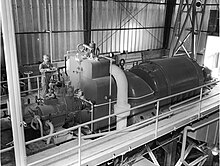
A boiling water reactor (BWR) is a type of light water nuclear reactor used for the generation of electrical power. It is the second most common type of electricity-generating nuclear reactor after the pressurized water reactor (PWR), which is also a type of light water nuclear reactor.

Argonne National Laboratory is a federally funded research and development center in Lemont, Illinois, United States. Founded in 1946, the laboratory is owned by the United States Department of Energy and administered by UChicago Argonne LLC of the University of Chicago. The facility is the largest national laboratory in the Midwest.

A nuclear meltdown is a severe nuclear reactor accident that results in core damage from overheating. The term nuclear meltdown is not officially defined by the International Atomic Energy Agency or by the United States Nuclear Regulatory Commission. It has been defined to mean the accidental melting of the core of a nuclear reactor, however, and is in common usage a reference to the core's either complete or partial collapse.
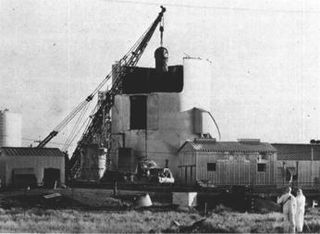
Stationary Low-Power Reactor Number One, also known as SL-1, initially the Argonne Low Power Reactor (ALPR), was a United States Army experimental nuclear reactor in the western United States at the National Reactor Testing Station (NRTS) in Idaho about forty miles (65 km) west of Idaho Falls, now the Idaho National Laboratory. On January 3, 1961, at 9:01 pm MST, an operator fully pulled out the reactor's central control rod, causing the reactor to go from fully shutdown to prompt critical. The intense heat from the nuclear reaction expanded the water inside the reactor core, producing extreme water hammer and causing water, steam, reactor components, debris, and fuel to vent from the top of the reactor where the three operators were working. As the water struck the top of the reactor vessel, it propelled the entire reactor vessel to the ceiling of the reactor room where it struck the overhead crane. A supervisor who had been on top of the reactor lid was impaled by an expelled control rod shield plug and pinned to the ceiling. The release of materials hit the two other operators, mortally injuring them. The reactor vessel then fell down to its original position.
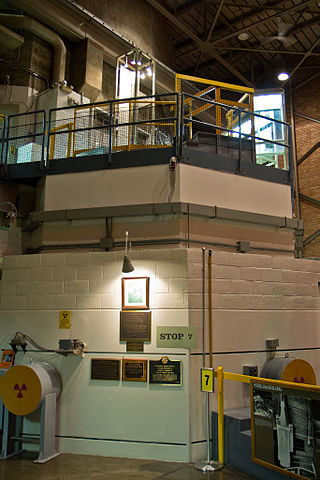
Experimental Breeder Reactor I (EBR-I) is a decommissioned research reactor and U.S. National Historic Landmark located in the desert about 18 miles (29 km) southeast of Arco, Idaho. It was the world's first breeder reactor. At 1:50 p.m. on December 20, 1951, it became one of the world's first electricity-generating nuclear power plants when it produced sufficient electricity to illuminate four 200-watt light bulbs. EBR-I subsequently generated sufficient electricity to power its building, and continued to be used for experimental purposes until it was decommissioned in 1964. The museum is open for visitors from late May until early September.

Idaho National Laboratory (INL) is one of the national laboratories of the United States Department of Energy and is managed by the Battelle Energy Alliance. Historically, the lab has been involved with nuclear research, although the laboratory does other research as well. Much of current knowledge about how nuclear reactors behave and misbehave was discovered at what is now Idaho National Laboratory. John Grossenbacher, former INL director, said, "The history of nuclear energy for peaceful application has principally been written in Idaho".
The Army Nuclear Power Program (ANPP) was a program of the United States Army to develop small pressurized water and boiling water nuclear power reactors to generate electrical and space-heating energy primarily at remote, relatively inaccessible sites. The ANPP had several accomplishments, but ultimately it was considered to be "a solution in search of a problem." The U.S. Army Engineer Reactors Group managed this program and it was headquartered at Fort Belvoir, Virginia. The program began in 1954 as the Army Reactors Branch and had effectively terminated by about 1977, with the last class of NPP operators graduating in 1977. Work continued for some time thereafter either for decommissioning of the plants or placing them into SAFSTOR. The current development of small modular reactors has led to a renewed interest in military applications.

The light-water reactor (LWR) is a type of thermal-neutron reactor that uses normal water, as opposed to heavy water, as both its coolant and neutron moderator; furthermore a solid form of fissile elements is used as fuel. Thermal-neutron reactors are the most common type of nuclear reactor, and light-water reactors are the most common type of thermal-neutron reactor.
In nuclear engineering, prompt criticality describes a nuclear fission event in which criticality is achieved with prompt neutrons alone and does not rely on delayed neutrons. As a result, prompt supercriticality causes a much more rapid growth in the rate of energy release than other forms of criticality. Nuclear weapons are based on prompt criticality, while nuclear reactors rely on delayed neutrons or external neutrons to achieve criticality.
Passive nuclear safety is a design approach for safety features, implemented in a nuclear reactor, that does not require any active intervention on the part of the operator or electrical/electronic feedback in order to bring the reactor to a safe shutdown state, in the event of a particular type of emergency. Such design features tend to rely on the engineering of components such that their predicted behaviour would slow down, rather than accelerate the deterioration of the reactor state; they typically take advantage of natural forces or phenomena such as gravity, buoyancy, pressure differences, conduction or natural heat convection to accomplish safety functions without requiring an active power source. Many older common reactor designs use passive safety systems to a limited extent, rather, relying on active safety systems such as diesel-powered motors. Some newer reactor designs feature more passive systems; the motivation being that they are highly reliable and reduce the cost associated with the installation and maintenance of systems that would otherwise require multiple trains of equipment and redundant safety class power supplies in order to achieve the same level of reliability. However, weak driving forces that power many passive safety features can pose significant challenges to effectiveness of a passive system, particularly in the short term following an accident.
Samuel Untermyer II, was an American nuclear scientist. He was the son of notable New York City jurist Irwin Untermyer and grandson of attorney Samuel Untermyer.

The Vallecitos Nuclear Center is a nuclear research facility, and the site of a former GE Hitachi Nuclear Energy electricity-generating nuclear power plant in unincorporated Alameda County, California, United States. The facility is approximately 30 miles (48 km) east of San Francisco, under jurisdiction of the US Nuclear Regulatory Commission's Region IV.
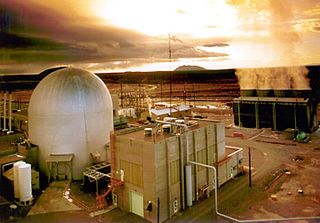
Experimental Breeder Reactor-II (EBR-II) was a sodium-cooled fast reactor designed, built and operated by Argonne National Laboratory at the National Reactor Testing Station in Idaho. It was shut down in 1994. Custody of the reactor was transferred to Idaho National Laboratory after its founding in 2005.
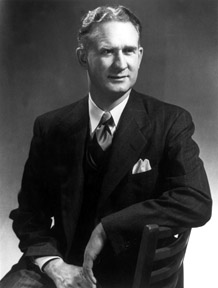
Walter Henry Zinn was a Canadian-born American nuclear physicist who was the first director of the Argonne National Laboratory from 1946 to 1956. He worked at the Manhattan Project's Metallurgical Laboratory during World War II, and supervised the construction of Chicago Pile-1, the world's first nuclear reactor, which went critical on December 2, 1942, at the University of Chicago. At Argonne he designed and built several new reactors, including Experimental Breeder Reactor I, the first nuclear reactor to produce electric power, which went live on December 20, 1951.

The Zero Power Physics Reactor or ZPPR was a split-table-type critical facility located at the Idaho National Laboratory, Idaho, USA. It was designed for the study of the physics of power breeder systems and was capable of simulating fast reactor core compositions characteristic of 300-500 MWe demonstration plants and 1000 MWe commercial plants.

The Sodium Reactor Experiment was a pioneering nuclear power plant built by Atomics International at the Santa Susana Field Laboratory near Simi Valley, California. The reactor operated from 1957 to 1964. On July 12, 1957 the Sodium Reactor Experiment became the first nuclear reactor in California to produce electrical power for a commercial power grid by powering the nearby city of Moorpark. In July 1959, the reactor experienced a partial meltdown when 13 of the reactor's 43 fuel elements partially melted, and a controlled release of radioactive gas into the atmosphere occurred. The reactor was repaired and restarted in September 1960. In February 1964, the Sodium Reactor Experiment was in operation for the last time. Removal of the deactivated reactor was completed in 1981. Technical analyses of the 1959 incident have produced contrasting conclusions regarding the types and quantities of radioactive materials released. Members of the neighboring communities have expressed concerns about the possible impacts on their health and environment from the incident. In August 2009, 50 years after the occurrence, the Department of Energy hosted a community workshop to discuss the 1959 incident.

The Materials Testing Reactor (MTR) was an early nuclear reactor specifically designed to facilitate the conception and the design of future reactors. It produced much of the foundational irradiation data that underlies the nuclear power industry. It operated in Idaho at the National Reactor Testing Station from 1952 to 1970.

The Transient Reactor Test Facility (TREAT) is an air-cooled, graphite moderated, thermal spectrum test nuclear reactor designed to test reactor fuels and structural materials. Constructed in 1958, and operated from 1959 until 1994, TREAT was built to conduct transient reactor tests where the test material is subjected to neutron pulses that can simulate conditions ranging from mild transients to reactor accidents. TREAT was designed by Argonne National Laboratory, and is located at the Idaho National Laboratory. Since original construction, the facility had additions or systems upgrades in 1963, 1972, 1982, and 1988. The 1988 addition was extensive, and included upgrades of most of the instrumentation and control systems.

Harold V. Lichtenberger was an American physicist who was involved in the planning of the Chicago Pile-1, the first nuclear reactor to achieve criticality, and in other reactor experiments at the Argonne National Laboratory.

